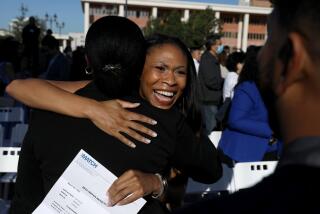Body of Knowledge Bound by Sacred Trust
- Share via
The end of the semester in the gross anatomy lab was drawing near when a first-year medical student decided to conduct a procedure that wasn’t included in the course syllabus. As word of her indiscretion -- a circumcision performed during an after-hours review with no instructors present -- passed through the lab, the reaction of the student’s classmates bordered on outrage.
“That’s just not right,” one indignant student said. “He didn’t ask for that to be done; she did that without his permission.”
The backlash I observed in the aftermath of the circumcision was powerful and heartfelt, suggesting to me that the mistreatment of cadavers is the exception, rather than the rule. At institutions like UCLA, where authorities now say they’ve uncovered the sale of cadavers and body parts, I believe such disrespectful, immoral behavior is also an anomaly. As is the case with all medical schools and public research institutions, the donor program at UCLA is predicated on an implied -- and sacred -- trust.
The New Jersey Medical School in Newark, where I chronicled the defining course in a medical student’s education, reinforced the meaning of that trust the day students were introduced to their “first patient.”
“Have reverence for the cadaver,” John H. Siegel, the now-retired chairman of the school’s Department of Anatomy, instructed during his introductory lecture. “For it is, in fact, a person who has made a sacrifice for your education.”
The admonishment was part of a two-sided bargain the medical school makes with donors. Those who donate their bodies to institutions of higher learning do so with certain expectations, chiefly that through a research arm or in a medical gross anatomy laboratory their gift will benefit tomorrow’s physicians and, in turn, every future patient in their care. Donors rightfully expect, in turn, that their bodies will be treated with respect and dignity.
In a parallel universe where an activity that polite society considers abhorrent -- systematic dismemberment -- is commonplace, the opportunities to disabuse that expectation are manifold.
Yet -- universally, in my experience -- respect for the donors is a mantra preached by students and instructors alike. This is not to say that medical students aren’t averse to using humor to stave off pressure.
To comprehend the myriad anatomical functions, the students embark on an emotional journey that transports them full circle.
The first stages of the dissection are marked by revulsion over what they are doing to someone they see not as a cadaver but as a husband, wife, father or mother to those left behind. By necessity, the human element recedes as the dissection progresses. And with detachment, the true intent of the donor’s gift is realized. Ironically, as the course winds down, with the body rendered nearly unrecognizable in conventional human form, the circle begins to close. The cadaver assumes, for the students, a separate human identity: that of their teacher. Most medical students honor the donors with a memorial service when the work in the anatomy lab ends.
To witness the spiritual and emotional component of these services is to know -- revelations about the activities at UCLA aside -- the inherent nobility of both the donors and the beneficiaries of their donation.
Having witnessed the activities in an anatomy lab, I’ve often been asked whether I would donate my body to medical science. My response is best articulated by the medical student, now a physician -- and a fine one, I haven’t a doubt -- who seven years ago delivered these remarks to her classmates at the New Jersey Medical School memorial service: “Any procedure we perform, every diagnosis we make, is all made possible by our first patient, our cadaver. In this manner, our cadaver goes on living and has an impact after death that few people have in life.”
Stephen Giegerich is author of “Body of Knowledge: One Semester of Gross Anatomy, the Gateway to Becoming a Doctor” (Scribner, 2001).






